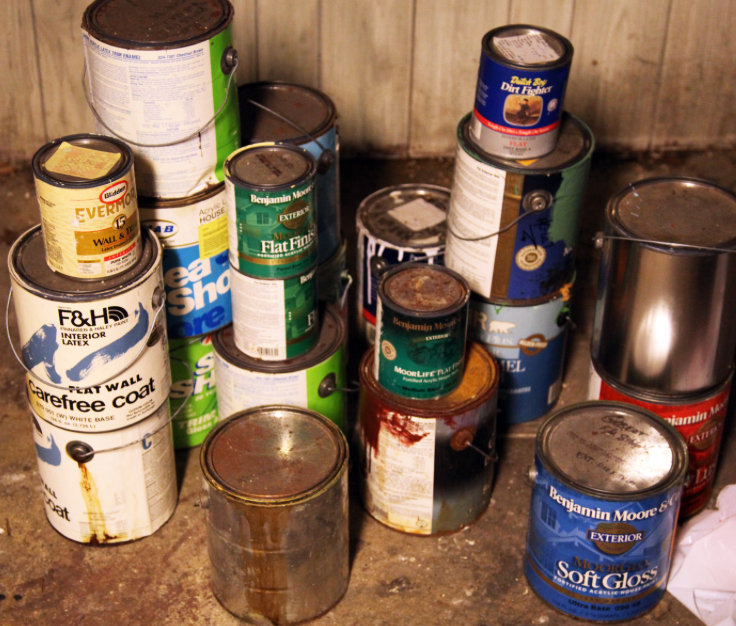Making good use of waste paint
Paint is a super useful substance used by us all...but we buy too much of it and waste paint is a very big environmental problem that AkzoNobel and the British Coatings Federation want to tackle

Akzo Nobel - manufacturer of Dulux paint - and the British Coatings Federation are both working hard to tackle the significant environmental problems caused by waste paint. We need to divert it from landfill and recycle and re-use it; presently around 13 per cent of all paint bought in the UK (around 55 million litres) is thrown away and is disposed of in landfill or by incineration. Pictured above: German photographer Martin Klimas uses vibrations resulting from playing music to cause paint to 'erupt' into his joyous Sonic Sculptures.
At Deco we've enjoyed two trips to the House of Commons to hear from experts looking to tackle the problem of waste paint. Chemicals giant AkzoNobel has produced a report, ReColour, which outlines how more paint could be collected and re-used, while the British Coatings Federation has launched its PaintCare initiative to create a circular economy for leftover decorative paint in the UK.
Over the past 20 years government legislation has forced paint manufacturers to take out of their products many of the solvents and other chemical nasties that used to be in paint, so the products we use in our homes today are far more eco friendly than they were.
Re-use and buy only what you need
However, paint isn't a harmless substance that can be tipped down the sink or into garden soil and therefore disposing of it safely is a problem. The obvious answer is not to dispose of it but to re-use it; and perhaps better still, for people not to over-buy. Consumer research shows around 30 per cent of us admit to buying too much paint for our projects. To stop this happening shops and online stores need to offer better advice on quantities, so we know, for example, how many 2.5L tins we'll need for two coats on the walls of a room that measures, say, 14x15ft.
The scale of the problem
AkzoNobel and the British Coatings Federation (BCF) think it's important we understand the scale of the problem. Of the 400 million litres of paint bought in the UK each year, around 13 per cent, or 55 million litres/71,500 tonnes is thrown out. And many more gallons of paint lurk in our lofts, understair cupboards and garden sheds because our households have between 6 and 17 partially-used tins of paint that we keep because we think we'll need them for future touch ups/repairs.
Except if we do remember to revisit those old tins, the paint inside isn't useable as it's dried to a solid...and that's because we didn't press the lid on securely when we put it away. So we go out to buy more paint and the whole waste cycle starts over.
Disposal isn't the answer
The problem with paint is it doesn't biodegrade and nor to its tins, so if paint cans are sent to landfill they contribute to land congestion and contamination, and to the build up of methane gas. Burn paint and you're creating greenhouse gases.
So what can be done?
Matt Pullen, MD UK & Ireland for AkzoNobel Decorative Paints, explains that the company wants to involve other sectors (waste management, logistics companies and 'green' entrepreneurs) in the seach for long term sustainable ways of reusing paint. AkzoNobel has for the past 20 years supported the Community RePaint organization that collects and re-distributes reusable leftover paint to community groups and people in social need who can't afford new paint to re-decorate their homes. But this small organization can't deal with the total amount of waste paint and the industry needs to come together to find ways to collect waste paint on a national scale so more communities can make use of it.
Easier recycling
Akzo and the BCF want more local authorities to accept waste paint at their recycling centres, as presently only 39 per cent do. But that number looks like it's rising already...earlier this year Islington recycling centre in north London started accepting paint tins and likewise in other parts of the capital. You can lobby your local authority to accept paint because if we can get our recycling depots to accept it, they can become hubs for the distribution of waste paint tins to re-manufacturing plants that it's hoped will start to proliferate in the country. AkzoNobel also recommends that sales of re-manufactured, re-used or recycled paint products to social enterprise or community-based groups should be exempt from VAT, as this would encourage them to use them.
Remanufacturing new from old
We may assume it's straightforward to incorporate waste paint into new...just slosh it into the vat and let the mixer do the rest. However it's a complex process technically; while moving waste material from one location to another involves complying with strict waste handling laws and regulations, remanufacturing centres have to be inspected and licensed by the Environment Agency, and planning regulations have to be met before a plant can be established. Therefore AkzoNobel wants government to look at regulations that may be hindering both recycling and remanufacturing paint.
PaintCare
The BCF shares AkzoNobel's ambitions to drive the re-use of waste paint and its PaintCare report makes the case for creating a circular economy for leftover paint. After undertaking in depth research it has recommendations for central and local government, and for the paint industry. Click here to find out more about Paintcare.
Do your bit
While the industry deals with the big issues involved in recycling and reusing waste paint, there is a lot we can do to cut down on paint waste.
*Start with buying only what you need - Dulux and other manufacturers have introduced online calculators to help us better estimate the amount of paint we'll need.
* If you have paint left in a tin, press the lid back on properly so the paint won't dry out. That way you can re-use it for touch ups and repairs in your home.
* If you have paint you know you won't need, contact Community RePaint to see if they can take it.
* Check whether your local council is involved in paint recycling.

